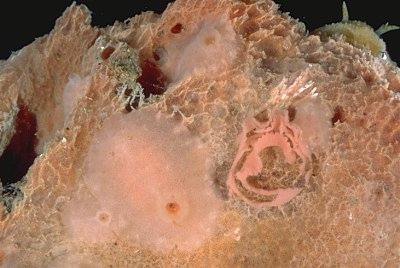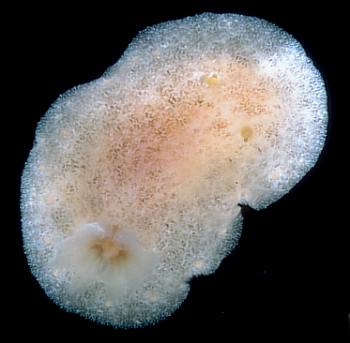

Rostanga australis
Rudman & Avern, 1989
Order: NUDIBRANCHIA
Suborder: DORIDINA
Superfamily: EUDORIDOIDEA
Family: Dorididae
DISTRIBUTION
The species is presently known only from Victoria and South Australia, Australia.
PHOTO
Portsea Pier, Port Phillip Bay, Victoria, Australia. 3 m, 20 specimens (6-32 mm long alive), 6 March 1986. PARATYPES AM C149545.
Upper photo shows many animals and egg ribbon on food sponge, Psammopemma sp.. PHOTOS: Bill Rudman.
See also R. australis - Radula.
See also R. australis - Anatomy
Smaller specimens are translucent white with varying amounts of brown pigmentation forming specks or patches on the dorsal epithelium. These specimens are consequently cryptically camouflaged on their food sponge. Larger pigmented specimens tend to match their food sponge in colour, apparently incorporating the sponge pigmentation in their tissues. One large specimen from South Australia (AM C145182) was pale yellow-brown with a microscopic network of white and dark brown specks each colour forming its own irregular reticulate pattern . Around the mantle, just in from the edge, are spherical pale orange-yellow mantle glands. The caryophyllidia are a pale orange-yellow with a set of white specks at the tip between the protruding spicules. The rhinophore stalk is transparent and the club is translucent brown with white patches at the upper end of each lamella. The terminal knob is brown. The gills are a translucent buff with small dark brown and larger white speckling. A large number of specimens were found in Victoria (AM C149545) on an orange sponge. The background colour was a pale orange-pink with a clear submarginal row of opaque mantle glands. In some specimens there was a scattering of brown patches or specks and some white speckling. The caryophyllidia, as in the South Australian specimen, were pigmented. In some specimens there is a trace of a T pattern on the dorsum with a median line, slightly lighter in colour than the rest of the epithelium, from the gilts to the rhinophores, and a line between the rhinophores. The rhinophore clubs are a translucent orange with a white patch on the upper end of each vertical lamella. In all specimens there is a brown ring around the stalked translucent terminal knob of the rhinophore. The gills are translucent pink with white speckling especially around the upper end, forming a white fringe to the gill cylinder. The body is similar in shape to R. arbutus but in larger specimens the mantle skirt is proportionally wider and the profile slightly more flattened. The caryophyllidia are typical for the genus as are the tripinnate gills forming an upright cylindrical circle. The rhinophores have vertical lamellae and a stalked posterior knob.
Egg masses were found on the sponge food (AM C149545). The pinkish-orange eggs are very small and closely packed in a thin transparent ribbon arranged in a spiral of approximately three coils. The free edge of the ribbon is distinctly crenulate. The size of the eggs and type of egg ribbon are typical of planktotrophic larval development.
Specimens from South Australia and Victoria were found feeding on colonies of a species of the arenaceous poecilosclerid sponge of the genus Psammopemma (Family Desmacididae). In South Australia the sponge had a greyish-purple exterior, (although the interior was a pinkish orange colour) while in Victoria the sponge was pale orange. In both cases the specimens of Rostanga approximated the colour of the sponge colony with which they were associated.
Rostanga australis is unusual for the genus in not being bright red or orange-red. Specimens have ranged in colour from pale yellow-brown to pale orange, matching the colour of the sponge they are feeding on. Juveniles can be a translucent white. The radula is very distinctive with the innermost lateral teeth having a few small inner denticles in juvenile specimens and none in adults. The outermost lateral teeth have four or five short rounded terminal denticles rather than the long rod-like denticles more typical of the genus. The heavily scalloped outer edge to the egg ribbon is also unique.
The species is presently known only from Victoria and South Australia. The name australis refers to this southern distribution.
Reference:
• Rudman, W.B. & Avern, G.J. (1989). The genus Rostanga Bergh, 1879 (Nudibranchia:
Dorididae) in the Indo-West Pacific. Zoological Journal of the Linnean Society 96: 281-338.
Rudman, W.B., 2002 (February 4) Rostanga australis Rudman & Avern, 1989. [In] Sea Slug Forum. Australian Museum, Sydney. Available from http://www.seaslugforum.net/factsheet/rostaust
Related messages
-
Rostanga australis from Victoria, Australia
From: John Chuk, July 2, 2003 -
Rostanga australis from South Australia
From: John Chuk, June 25, 2002 -
Rostanga australis from Victoria, Australia
From: John Chuk, June 25, 2002 -
Rostanga australis from South Australia
From: Bill Rudman, February 8, 2002
